On a Friday evening earlier this spring at St Edward’s School, the stage was set – not for an ordinary performance but for something built from the ground up by the imaginations of Oxford’s young people. The Let’s Build a Town! concert, led by Music at Oxford (MaO), alongside students from Oxford’s St Francis C of E Primary School and Oxford Spires Academy, was the culmination of a series of creative workshops with the schools, in which children designed their own town – one without adults, shaped entirely by their ideas of an ideal community.
Under the guidance of professional musicians, educators and theatre-makers, the children transformed their ideas into music, theatre and movement. In the spirit of composer Paul Hindemith’s 1930 original, which inspired the collaborative project, young people from Oxford made his nearly century-old work feel entirely fresh and current as they performed co-created music and theatre which spoke to contemporary issues of community-building and identity.
After the performance, participants and members of the artistic team took part in a talk with audience members, sharing insights into the project and its impact on the young participants’ confidence and creative skills.
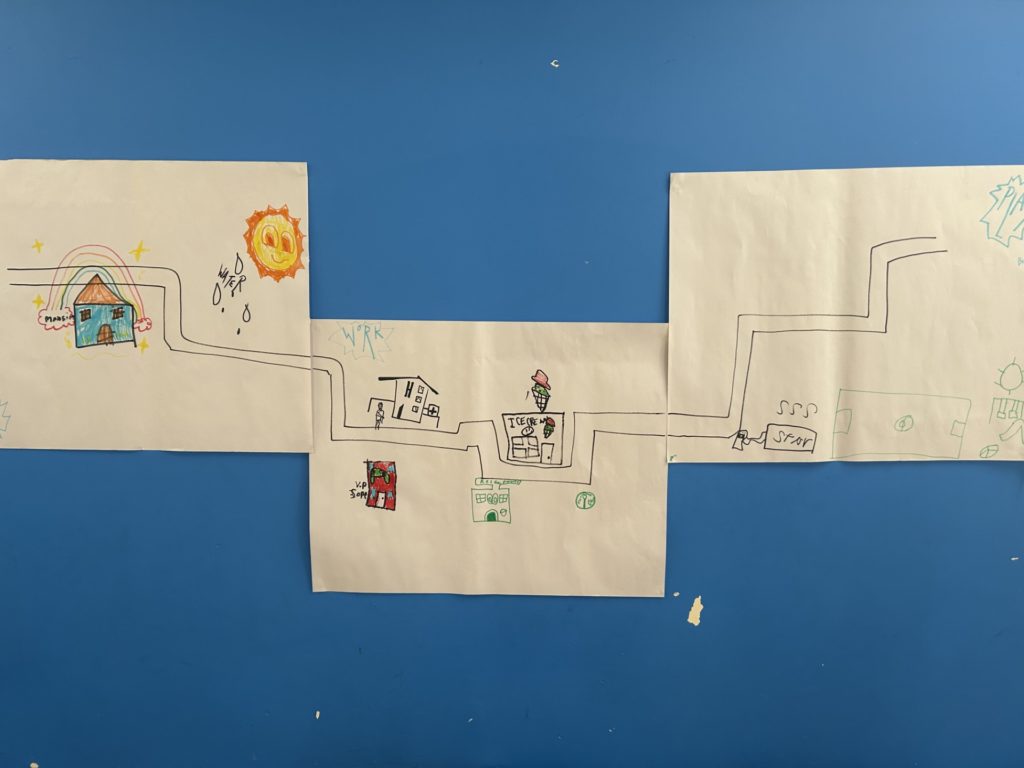
For Giles Masters, Fellow at Magdalen College and curator of the project, the experience was as inspiring as it was moving. Read what he had to say:
“To witness our town come to life through performance was joyful and moving. The children used their creativity, teamwork and all sorts of different skills – singing, dancing, speaking, playing, building – to create something that was so much more than the sum of its parts. I loved seeing how they rose to the occasion of the performance and how proud they and their families were of what they had achieved.
If I had to choose highlights (which is hard – there were so many!), I would pick out two things. First, the announcements between scenes, when children took turns to come up to the microphone in the middle of the stage to share some of their ideas about what their ideal town might be like (we need enormous 6-decker buses, obviously). These were by turns funny, charming and genuinely thought-provoking. I was really impressed by how brave all the young people were about speaking to such a big audience!
Second, as the music historian on the project, I really enjoyed seeing how much the children took to singing Hindemith’s music and making it their own. Although Hindemith’s original piece is nearly 100 years old, through their energy and commitment, the young people from St Francis made it feel totally fresh and of today.
Many thanks and congratulations to all the participants, the schools, our creative team and our partner organisations for joining us on this project – you achieved something really special. Now, it’s time for everyone to lay down their buckets and shovels and enjoy a well-earned break.”
‘Let’s Build a Town!’ captured the energy and creativity of the young performers, and offered a thought-provoking reflection on the ways we build and shape communities today.
For Felicity Newby-Smith, Educational lead from Music at Oxford, the project was more than just a performance – it was a journey of personal transformation for many of the young participants, read as she reflects on the event:
“The joy surrounding the performance on the night was completely infectious; there was laughter, cheering and applause, and I loved looking around the audience to see huge smiles on so many adults’ faces! For grown-up members of the audience it was a reminder of how to be a child; how to play, how to create something from almost nothing and ultimately how to have fun!
The children from St. Francis Primary School who performed on the night blew me away with their commitment, confidence and energy. This was visible (and audible!) while watching them perform as a group, and the team work that involved, but what was really special to me was the added awareness of the journeys individual children had taken during our project Let’s Build a Town!. When we first arrived in January, there were a few children who were so lacking in confidence that they struggled to even engage in simple classroom discussions or warm-up games. Fast-forward to the final performance and I had to pinch myself as I watched those same children performing with such dedication and confidence, in some cases having chosen solo roles for themselves, all in front of 300 members of the audience!
I’ve always known that the value of making music is unparalleled, especially for children, but what I wasn’t expecting was the realisation that by engaging with the performing arts, even for a relatively short period of time, those children had gained transformational skills that would set them up for the rest of their lives.”
By the end of the evening, it was clear that Let’s Build a Town! had created something far greater than just a performance. It had built confidence, creativity, and a sense of shared community among the children, teachers, and artists involved.
Let’s Built a Town was produced by Music at Oxford in collaboration with The University of Oxford’s Cultural Programme, and with the support of the Faculty of Music, Magdalen College, RETUNE Festival and the Marchus Trust.
Featured image: Simon Vail Photography
We are seeking an experienced Site/Production Manager to collaborate closely with the Associate Co-creation Producer (from the University of Oxford’s Cultural Programme), Creative Lead, and Event Coordinator, overseeing the safe and efficient delivery of the festival site.
The successful candidate will:
- Oversee the build and de-rig of the site, supervising infrastructure setup, contractor activity, and technical requirements.
- Take on a leadership role when the Event Manager is unavailable, ensuring continuity of oversight across the event.
- Ensure that temporary structures, staging, power supplies, and high-risk areas are installed and managed according to safety specifications and risk assessments.
- Act as key liaison for technical and production-related matters, communicating with contractors and crew and ensuring all logistics are running to schedule.
- Maintain radio contact throughout the day and be part of the event’s live command structure.
- Oversee delivery of protocols on the day including DBS, lost child, and vulnerable adult procedures.
Fee: £200 per day over 7 days (£1,400 total)
Work to be scheduled between mid-June and early July, with availability required for the festival day on Saturday 5 July 2025.
We strongly encourage applications from individuals with lived experience of or connection to the Blackbird Leys community.
To Apply:
To submit an Expression of Interest, please send a CV and short cover note (including your availability and confirmation of day rate) to:📧 nassykonan@humanities.ox.ac.uk.
Please include “Site/Production Manager EOI – Leys Festival” in the subject line.
Deadline: Monday 9 June 2025
About the Cultural Programme, Humanities Division, University of Oxford
The Cultural Programme brings together university, local and global cultural communities in a physical and digital arts centre, powered by the University of Oxford’s research. We promote broad engagement with the riches of the humanities by working with outstanding artists, writers and thinkers from around the world to create and present world-class arts and culture.
From 2026, the Cultural Programme will be located within the Stephen A. Schwarzman Centre for the Humanities – a home for seven humanities faculties and the University’s first purpose-built cultural venue, featuring a concert hall, theatres, film and digital spaces, and public exhibition areas. We continue to deliver an ambitious offsite programme in the lead-up.
Ahead of A Grand Celebration of Le Concert Spirituel at the Sheldonian Theatre on 13 June, we sat down with conductor Edward Higginbottom to explore the origins of one of Europe’s earliest public concert series, and its legacy. From the distinctive sound of period instruments to the interpretive choices behind historically informed performances, Edward Higginbottom’s reflections on Le Concert Spirituel offer a fascinating glimpse into a musical world that still echoes in our own.
Could you tell us about Le Concert Spirituel, and how it began?
Edward Higginbottom: Le Concert Spirituel is a concert organisation in Paris, begun in 1725, by Anne Danican Philidor. And, you might ask, why ‘spirituel’? Because Philidor always had a grand motet Psalm setting in the programme. And why was that? These concerts always took place on a Christian feast day, so Christmas, Easter, Ascension. There were quite a number of them, in the year maybe 20, or 25.
And why on those occasions? Because the opera was shut. If you were a music lover in Paris in those days, there was nowhere else to go. If the opera was shut, what could you do about your music consumption? Philidor had the idea of offering these concerts, which would recognise the Christian nature of the day, but also offer a wide range of other sorts of music. This was an organisation that put on concerts, over 1000 of them, throughout more or less the whole of the 18th century, and was a crucial feature of public music making in Paris, and indeed in Europe, of the day.
What role did it play in shaping the idea of a ‘public concert’?
EH: We’re very used to public concerts in our own day. We see them advertised, we buy a ticket, and we go. In the 18th century, early on, there was no such thing, until Philidor came along and said, “we’ve got this concert, this programme of music, you can come if you pay adequately, and hear our best performers”, so that was quite a novelty.
It had been going on [before 1725] in aristocratic homes, in the homes of the wealthy. Privately, it had been going on at court. But as a public subscription event, it wasn’t really a part of the social life, the musical life in Paris, until this point, so it’s really significant. It marks a moment when the public concert became a thing, and you could book and go, and enjoy, or hiss or boo, whichever you liked! It was about the public consumption of music for the first time on a significant level.
And what sort of music would a listener have heard at a Concert Spirituel performance? Was there a standard programme?
EH: The type of music you would hear at the Concert Spirituel comprised, always, a grand motet, a large-scale cantata setting of about 20-25 minutes, which would be a psalm setting. That was the significant nod to the Christian feast day – that was always part and parcel of the event, because quite often, you’d have been to church in the morning for mass and would go to the concert in the afternoon. So, there would be a big choral item, orchestral and choral music, and then there’d be some instrumental music.
At the very first concert there was [Arcangelo] Corelli, and his Christmas concerto was played. And that sort of music, Italian-based concerto music, became a mainstay of the programme planning. A lot of concerto composers are represented in the programmes. The symphony also crept in. There weren’t really any symphonies in 1725, which we’d recognise these days as symphonies. But bit by bit, this genre, a very public genre, took hold and found a place in the Concert Spirituel, so very important instrumental genres were represented in the programme.
And then you might have rather small-scale things. One of the things we’re performing on the 13th of June is a very small-scale cantata by [Louis-Nicolas] Clérambault. That’s unusual in respect of it reducing to just five performers, from a big orchestra and chorus. That doesn’t often happen in modern concerts, because you tend to stay with the group that’s installed on the stage. But they had a lot of variety, solo items, larger items, and then these full-scale symphonic items. So it’s a real melee of music, a lot of different stuff, and increasingly, putting an accent on the instrumental.
In what other ways would the experience of attending a Concert Spirituel performance differ from we’re familiar with now?
EH: I think the public was much pickier than we expect concert audiences to be today! For instance, when Mozart composed his symphony for the Concert Spirituel, which we know now as the Paris symphony, which we are going to play [on 13 June], in 1778, at the first performance, the slow movement was not much appreciated. In fact, it was criticised in the press as being overly complex. The second performance was a chance that Mozart then had to do something about that. So, he composed another slow movement, which was duly played on the second performance, and applauded more warmly by the press and public. The response from the public was in a manner that was more unbuttoned, and [the public] would say what it thought. When we do our concert on the 13th of June, we’re going to play both of these slow movements, and we’re going to ask the audience to indicate which they preferred. We’ll have a couple of urns where you’ll be able to drop a token to let us know which movement you preferred.
Another difference was the diversity of repertory. There’d be small scale, there’d be choral, there’d be instrumental, there’d be people who were valued for their prowess as soloists – concerto soloists and vocal soloists. That rich mixture of everything you could possibly hear musically, chamber music up to the grand scale, would be present at these events.
Could we talk about the instruments themselves? What sets ‘period performance’ apart, and how does it shape the way we experience 18th-century music today?
EH: Quite often people ask what it is about period ensembles, or period performance, that’s different. The primary difference is the instruments used. These are instruments which are either 18th century instruments, or copies of 18th century instruments, and they’re not the same [as instruments today]. The violins have less of an angle on the fingerboard, they don’t have a chinrest, they have gut strings, the bows are not shaped in the same way. The sound you get from them is definitely different.
The woodwind instruments, the flutes and the oboes, are differently constructed and have fewer keys and a different timbre. The brass instruments are natural and have no pistons. It’s quite a different sound world. It requires proficiency on those instruments. Then there is a way of performing the music, which bit by bit you can forget. Of course, in their day, you wouldn’t think at all that what you’re doing could be part of the currency of the time. But if you perform 18th century music now, you have to look carefully at the evidence concerning how it was performed. There’s a lot of evidence, including treatises on performance, on various ways of playing your instrument, and various ways of construing the notation.
The notation tended to be quite economical. You’d certainly have the notes, their values and their pitches, but dynamics – a few, not many. Crescendo, diminuendo marks – not many of those either. Phrasing – not at all, really, some bow marks. There’s a lot you have to see underneath that notation, or behind it, to get the best out of this music, so that is what we are doing when we play period instruments and perform in a period style.
A Grand Celebration of Le Concert Spirituel takes place on 13 June at the Sheldonian Theatre, Oxford. Join us for an evocative evening of music that reimagines one of Europe’s most influential early concert series.
This is an open invitation to get involved in the Cultural Programme Season on Utopia Now! which will
take place in the Schwarzman Centre in Michaelmas 2026.
A core group of researchers, led by Professor Peter Boxall (English), Professor Wes Williams (MML), and
Professor Paul Basu (Anthropology/Pitt Rivers Museum) are already collaborating with the Cultural
Programme on inspiring opportunities for the season (see the full description of the season below for
more details).
We are keen now to extend an open invitation to any others who might like to be involved to join the conversation.
There are different ways to get involved:
- Faculty- or Institute-led events: let us know about the events you are organising for Michaelmas 2026 that could align with the season description below and benefit from collaborative marketing and promotion.
- Apply to the Cultural Programme Open Call: for small, research-embedded cultural projects.
Link to call: https://oxfordculturalprogramme.org.uk/oxford-is-open-to-new-ideas/
Next deadline: MT25 – Thursday 16 Oct (first stage). - Contribute to the season exhibition – The Principle of Hope: this exhibition will take place in the brand new White Box Exhibition Space in the Schwarzman Centre. See further details below from the curator Professor Paul Basu.
- Send us an idea: we are very happy to discuss individual ideas and ways to get involved. Send us an email or come along to the next meeting. Send ideas/queries/questions to: culturalprogramme@humanities.ox.ac.uk
Join us for the next meeting: Tuesday 10th June, 3.00-4.15 in the Colin Matthew Room at Radcliffe Humanities. RSVP to: culturalprogramme@humanities.ox.ac.uk
SEASON OVERVIEW – UTOPIA NOW!
Can we imagine and build a world better than the one we live in now?
In our time, such a question might seem naïve, fanciful, or even offensive. Technological revolution is realising many of the marvels that we only dreamt of in our science fictions – artificial intelligence, generic engineering, the automation of virtually every kind of labour, the colonisation of Mars. But such developments can feel more terrifying than liberating. Artificial intelligence threatens to replace the human rather than enhance it; corporate technology worsens global inequality rather than reducing it; and the carbon cost of computing is part of a climate emergency that poses a real and present danger to our collective futures. Is now really the time to engage deeply with the history and the future possibilities of utopian imagining?
Utopia Now! will show that utopian thought does not diminish at times of rapid and disorienting change, such as our own. Rather, it thrives.
Utopian possibility emerges, and imposes itself, when an old world is lapsing, and a new one has not yet been born. In the inter-regnum, the No-place of the present moment, critical imagination is called upon to undertake the task of world building, of willing a new and better future into being.
This Season, in calling for Utopia Now, brings together thinkers and practitioners from across the arts, humanities and sciences, to project images and recount stories of utopian possibility at a critical moment in our shared history. Embracing all forms of creativity and connection, the season will generate a collective picture of the future, which emerges from the long, sometimes complex, and often conflictual tradition of utopian thought, reaching from Thomas More, through the present and into the future.
Celebrating the opening of the Schwarzman Centre for the Humanities, Utopia Now brings together the university and the city in unexpected ways. Exploring Utopian practices at local, global, and planetary scales, we harness the power of the creative imagination in making new and better worlds possible.
The time for utopian imagining has not passed, and is not to come. It is Now.
EXHIBITION OVERVIEW – THE PRINCIPLE OF HOPE
An exhibition is being curated by Paul Basu (School of Anthropology & Pitt Rivers Museum) as part of the Utopia Now season with the working title ‘The Principle of Hope’. The plan is to develop a highly interdisciplinary exhibition, incorporating collections from the University’s various museums and libraries, contemporary art and digital installations. One part of the exhibition will explore different historical and cultural visions of ‘better worlds’ (whether expressed in art, artefacts, text, etc.), but also the ‘unliveable worlds’ which give rise to parficular utopian imaginaries. It is hoped to identify items in Oxford museum/library collections that speak to both present ‘dystopias’ (e.g. ecological crisis, biodiversity loss, colonial destruction of other ways of being/knowing) and past/present utopian visions (e.g. images of paradise, golden ages, social and technological utopias, ecotopias) and Paul Basu would welcome hearing from colleagues whose research interests engage with these issues and/or who have suggestions for Oxford museum/library collections that speak to such themes. Please contact Paul at paul.basu@anthro.ox.ac.uk.
As preparations are underway for a special concert tomorrow night (Wednesday 7 May) celebrating the music of Johann Sebastian Bach, we take a moment to reflect on the remarkable journey of the manuscript that inspired Bach 1725. Newly acquired by the Bodleian Libraries in 2024, this treasured document, rich with historical significance, offers a rare glimpse into Bach’s creative process in the mid-1720s. In the article below, the Bodleian Libraries’ Alfred Brendel Curator of Music, Martin Holmes, explores the story behind the manuscript, tracing its path through the centuries to its new home in Oxford, and the steps taken to preserve it for future generations.
News that the Bodleian Libraries might acquire a Bach autograph first reached me in April 2023. Since only two other institutions in the country have Bach autograph manuscripts in their possession, the possibility of one coming to Oxford was immensely exciting. It was being offered in lieu of inheritance tax by the family of Sir Ralph and Lady Kohn and the application was being handled by Sotheby’s. I was immediately set to work on building a case for Oxford as the Government began the process of assessing the tax value of the manuscript and deciding to which institution it should be allocated. It was known that the Kohn family were keen for it to come to the Bodleian but that outcome was not a foregone conclusion. However, with the help of Dr Stephen Roe (formerly of Sotheby’s) and current Sotheby’s staff, the application was assembled and after a tense few months the final decision to allocate the manuscript to the Bodleian was made by the then Secretary of State and communicated to Bodley’s Librarian by Arts Council England. The manuscript was delivered to Oxford on 29 January 2024 and unpacked with much anticipation (and not a little trepidation) by Bodley’s Librarian and a small group of senior Special Collections staff.
Sir Ralph Kohn (1927–2016) had purchased the manuscript at a Sotheby’s sale in 1989, and it was considered to be the last major Bach manuscript in private hands. Sir Ralph was a distinguished biomedical scientist and pharmaceutical entrepreneur. He was also a keen musician and an accomplished amateur singer who, having been born in Leipzig, felt a natural affinity with J.S. Bach. A discerning collector, he built up a choice collection of musical manuscripts and first editions of works which meant a lot to him.
After Bach’s death in 1750, the manuscript scores of most of his works were inherited by his eldest son, Wilhelm Friedemann (1710–1784) who was living in Halle at the time. It is clear that W.F. Bach performed the work himself at some point, since some of his markings have been detected on the manuscript. He moved to Berlin in 1774 where he remained for the rest of his life and taught the harpsichord to Sarah Levy, Felix Mendelssohn’s great-aunt.
What happened to the manuscript next is not quite clear. W.F. Bach is known to have had financial troubles and sold off some of his father’s manuscripts. However, in 1827, it was acquired, along with manuscripts of a dozen more cantatas from W.F. Bach’s estate, by Carl Pistor (1778–1847), a civil servant with an obsession for precision optical instruments, which he manufactured in conjunction with one of Felix Mendelssohn’s uncles. He was also a passionate music lover and gave the young Felix the task of sorting his collection. Pistor’s daughter Betty sang with Mendelssohn in the Berlin Singakademie and she was the object of his teenage affections for a while until a rift developed between the two families. Betty Pistor eventually married Adolf A.F. Rudorff (1803–1873) and the manuscript remained in their possession until around 1854 when it was given to the conductor and composer Robert Radecke (1830–1911). From him, it passed to his grandson, Ewald Radecke (1907–1979) and it remained in the Radecke family until coming to auction at Sotheby’s in 1989.
The manuscript comprises sixteen pages in four unbound bifolia. In common with most of Bach’s manuscripts, it was written on paper with corrosive iron-gall ink which presents modern conservators with a considerable challenge if these documents are to survive for future generations to study and enjoy. A particular problem with music notation is that the forming of note heads causes high concentration of ink in small areas which often causes brown discoloration beside the ink and through the paper. In acute cases, the ink can literally burn through the paper, creating cracks and losses where notes should be and severely weakening the structure of the paper. Given the corrosive nature of the ink Bach used, it is difficult to arrest this process completely.
Over the years, Bach manuscripts have been subjected to a variety of treatments, from splitting each page in two and inserting an acid-free barrier between them, to washing the paper with alkaline solutions. The Bodleian’s approach in this case is to avoid interventive measures and provide effective mitigation solutions. The priority will be to ensure that the manuscript can be securely housed and handled without risk of further damage. The bifolia, protected in custom made archival folders and box, will be stored in controlled environmental conditions. Handling will be kept to an absolute minimum. No further treatment is planned at this stage.

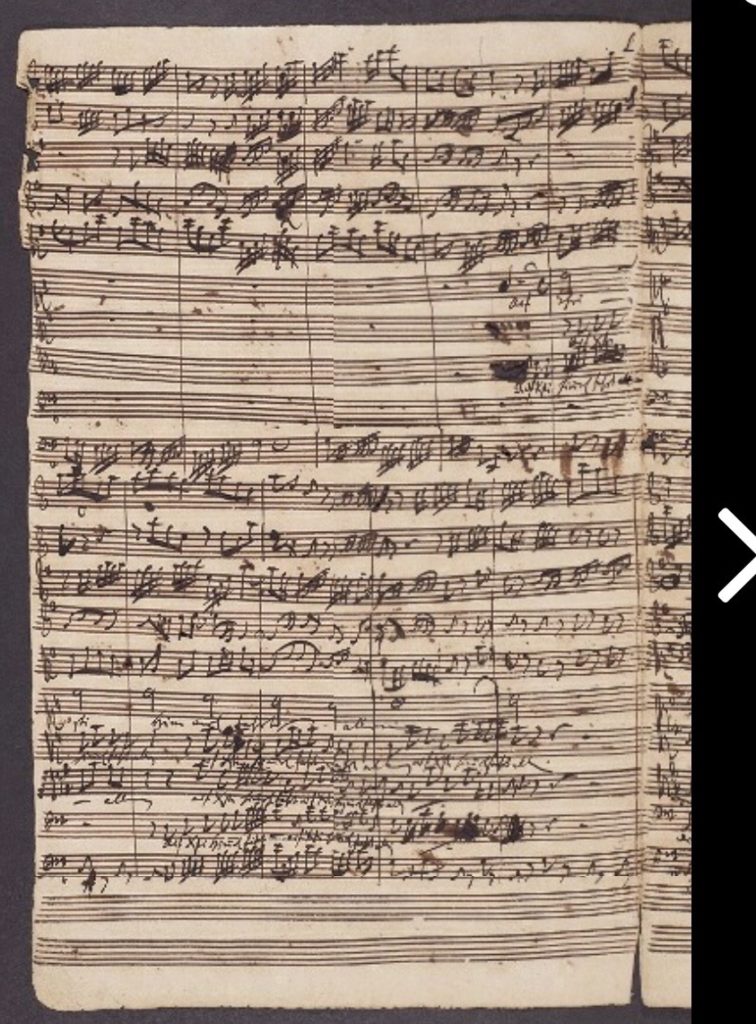
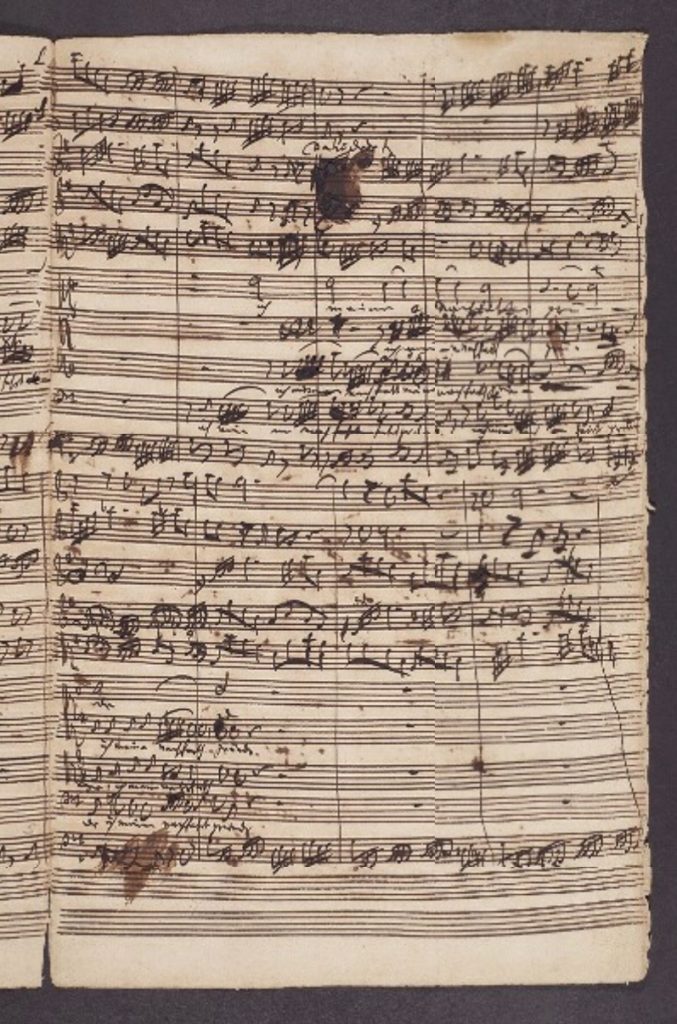
As soon as it arrived in Oxford, the manuscript was photographed by the Bodleian’s studio and high-quality digital images are now freely available in Digital Bodleian. Scans can never be a complete substitute for an original manuscript but the images will enable scholars and others with an interest in Bach to study many aspects of the music and the process of its composition without having to handle the original. In due course, modern multi-spectral imaging techniques could be used to reveal more about aspects of the manuscript which are less obvious to the naked eye, such as different layers of annotations on the score.
The cantata was first edited for publication by A. Dörffel in 1878, for the Bach-Gesellschaft edition, and the manuscript was presumably borrowed for that purpose. Indeed, discrete markings can be found in the manuscript which were added at that time. In 1960, it was re-edited by Alfred Dürr for the Neue Bach-Ausgabe, taking account of a surviving set of performing parts in Berlin. It is therefore unlikely that renewed study of the Kohn manuscript will cause radical changes to be made to the accepted musical text of the work. However, the manuscript will enable successive generations of scholars and students to see how Bach committed his thoughts to paper and feel the presence of one of the greatest musical geniuses of all time.
Martin Holmes is the Alfred Brendel Curator of Music, Bodleian Libraries. He studied Music at Worcester College, Oxford and first joined the Bodleian’s Music Section nearly forty years ago. After several cataloguing projects in Music and Rare Books, including the Tenbury and Harding collections and the library of John Locke, he spent a period as Head of Catalogue Support Services before returning to head up the Music Section on the retirement of Peter Ward Jones in 2009. He has a particular interest in English music and has written on various subjects, including the composer Ernest Farrar, the development of the Bodleian’s legal deposit music collections and the provincial book trade.
The manuscript is currently on display until 17 August 2025 as part of Bach: A Composer’s Obsession, a free display in Blackwell Hall, Weston Library. The manuscript is shown alongside a selection of items which illustrate the importance of Bach in the life and work of a later composer, Felix Mendelssohn.
Bach 1725, with a manuscript viewing and pre-concert talk, will take place at the Sheldonian Theatre on Wednesday 7 May.
The Cultural Programme is looking to engage a film consultant to undertake a short piece of consultancy to advise on the model for the film programme at the Schwarzman Centre Cultural Programme.
Requirement: an expert in the business of film programming is invited to respond to the brief through meetings with the Cultural Programme team and through the writing of a written report.
The consultant is not expected to undertake external meetings to map the landscape, or consult on the strategy around film, but the report may identify defined areas where further consultation is required.
The report should address:
1. How can a film programme best respond to Cultural Programme mission & vision and the context of the programme in Oxford’s Schwarzman Centre?
- What are the potential strands of the programme?
- Articulate these strands in relationship to audiences, artists, academic connection (both research and learning), partnerships, financial models, funders?
- Which strands should be priorities and why?
- Which strands should be avoided and why?
2. What resources does the Film Programme need, depending on its activity level:
- Financial resource
- Human resource
- Options around staffing a film programme? (Does it need a single programmer, or will we benefit from working with a range of curators? In which case, what management and administrative support will the programme need?)
Further details:
We expect this work to be completed within five (5) working days, ideally within May or June.
Payment will be after the completion of work. We expect to make payment via invoice. Individuals paid by the University must be set up on the University supplier system in advance of submitting an invoice.
TO APPLY:
To submit an Expression of Interest, please provide a CV and cover note (including details of your availability and day rate) to the Cultural Programme by Monday 28 April 2025. Please include “Film Consultant EOI” in the subject line.
Email to submit EOI: culturalprogramme@humanities.ox.ac.uk
Cultural Programme, Humanities Division, University of Oxford
The Cultural Programme brings together university, local and global cultural communities in a physical and digital arts centre, powered by the University of Oxford’s research. We promote broad engagement with the riches of the humanities by working with outstanding artists, writers and thinkers from around the world to create and present world-class arts and culture. Innovative and diverse, and delivered across music, theatre, dance, film and visual arts our programmes will be delivered in collaboration with university, local, national and international partners.
At the heart of our vision lies our commitment to:
- Creativity – unlocking new forms of digital authorship, imagination and participation
- People – empowering individuals and communities to generate and explore new forms of knowledge and experience and to become leaders in their own fields and disciplines
- Planet — we want to be connected locally, regionally and globally, in the most environmentally sustainable ways possible
- Innovation – advancing cutting-edge research methodologies in the arts and humanities at the interface of new technologies and digital media
Currently working offsite, from 2026, the Cultural Programme will be located within the Stephen A. Schwarzman Centre for the Humanities. The Schwarzman Centre will bring together seven of the faculties in the Humanities Division, an Institute for Ethics in AI and a multi-disciplinary cultural centre containing Oxford’s first purpose-built concert hall as well as further spaces for music, theatre, spoken word, literature, digital, film and exhibitions. As well as working in the new spaces of the Schwarzman Centre, the Cultural Programme will continue to deliver an offsite programme.
The Schwarzman Centre is a unique proposition bringing together a broad spectrum of academic and artistic disciplines teaching, research and public engagement including through arts and culture. The humanities embrace all the academic and artistic disciplines which together help us to develop our understanding of what it means to be human.
For more information, please visit https://oxfordculturalprogramme.org.uk.
Ahead of Bach 1725, Professor Martyn Harry spoke with renowned composer Judith Weir, whose new composition will premiere at the celebration concert on Wednesday 7 May. Commissioned by the Bodleian Libraries, Weir’s piece offers a contemporary reflection on Bach’s Ascension Day Cantata (BWV 128). Known for her innovative approach to storytelling through music, Weir shares the inspiration behind this new work, her experience of engaging with Bach’s music, and what she hopes audiences will experience during this special celebration.
Martyn Harry: Can you please tell us about your new work Upwards and how it relates to the Bach manuscript celebrated in tonight’s concert?
Judith Weir: I approached Upwards as an overture to the Bach cantata we are talking about – Auf Christi Himmelfahrt allein. It uses the same instruments as the whole cantata, including two horns and trumpet. Although I think it’s the case that in Bach’s day the trumpet player would have been one of the horn players, I took the opportunity to have the whole lot of them. I wanted it to be very closely related to the first movement of the cantata, because after all my piece will be immediately preceding that first movement. In other words, I was ignoring the rest of the cantata and just looking at that huge opening movement, which is a chorale-prelude, with a chorale sung by the trebles, very slowly over the top of the music.
I looked at the Bach both in the manuscript and the printed version, and started off by looking at actual figures that Bach uses to accompany his chorale. From there, I started to add my own notes and rhythmic figures. The thing that is so obvious in the whole cantata (about Ascension Day) is that the chorale melody in this movement is very flat in terms of contour whereas everybody else is playing leaping upwards figures all the time. So that really became my concept for the piece: the individual things that people play should always tend to be upwards scales or melodies in some way. And generally speaking, the music moves upwards through the piece and ends as an almost pictorial attempt at going up into the sky.
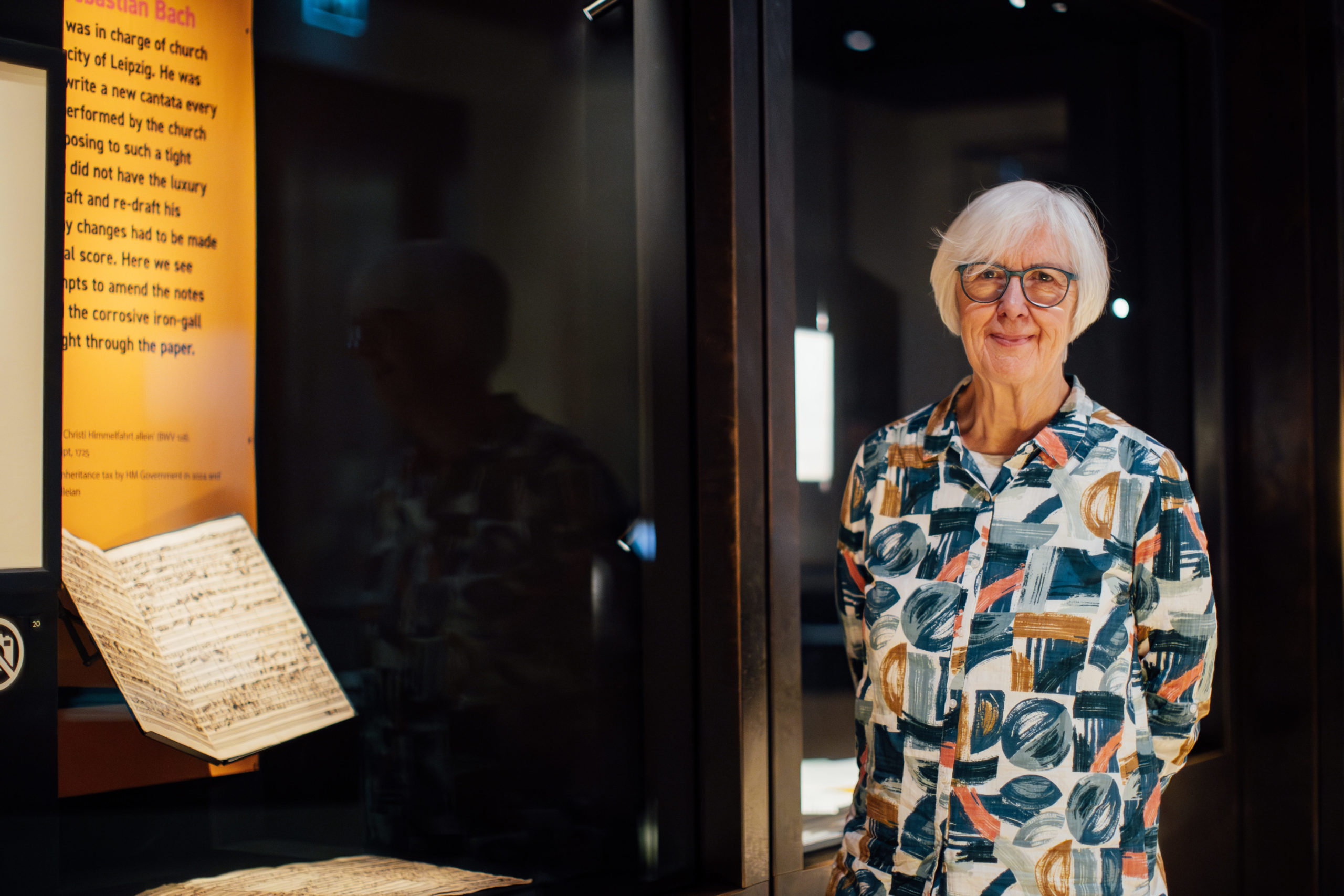
MH: This commission presents an exciting challenge in writing for the instruments and players of the Orchestra of the Age of Enlightenment. What is your approach for composing for early music instruments?
JW: I think particularly with instruments that we don’t really have now, like the oboe d’amore and the oboe da caccia, just to try and find out about them. To imagine as closely as possible the experience of the performers as they play these instruments. Speaking about those woodwind instruments, they don’t have so many helpful keys as modern instruments, so you have to think about the shape of your melodies: will this work for them? And of course, looking at these incredibly high brass parts in both the horns and the trumpets that we’re not used to in modern orchestral music. It would be a big ask to have, for instance, the horns playing quite so high all the time, but it certainly seems to work in the Bach.
So, I think my approach there is just to try and understand how those instruments are played and how can they do that. And of course it is terribly important to try and work out what the instruments can’t do, so for instance, these natural horns, they don’t have any extra valves, so you have to imagine them just playing a metal tube that can just play the harmonic series, plus maybe a little bit where the embouchure, the lip position, might help you to play something a little flatter or something like that. But on the whole, I try not to think of it as a restriction, it’s a chance to hear very different tones in the music I am going to write.
MH: When I first met you, you played the oboe. Have you found yourself re-engaging with your own playing experience of the oboe, given that there are three different types of oboe available in this piece?
JW: Well, I was lucky as a student that someone lent me a baroque oboe (it might have been a reconstruction). I didn’t make much of it! It was terrifically hard to think about how to create a reed and get it to do anything. So, I massively admire all the people in the last fifty years who have done that to such a high standard.
My memories of playing Bach as an oboe player are about the breath, the enormous solos that you play, particularly in the solo arias – we’ve got one actually in this piece – and just how strong and how careful you have to be about finding places to breathe. I do marvel at the fact that Bach’s work is just full of these. They are gorgeous tunes; they’re probably the best ever. But oboe music, it’s extremely difficult to play. And I guess, seeing these historical instruments, at least the physical strain isn’t so great, but I would think the finger problems must be pretty considerable!
Professor Martyn Harry is Professor of Composition at the Music Faculty, University of Oxford as well as a Fellow and Tutor at St Anne’s College and Lecturer at St Hilda’s College.
If you’d like to be there for the premiere of Judith Weir’s new work Upwards as part of a Bach celebratory concert, tickets are still available for Bach 1725 taking place on Wednesday 7 May. Presented by the Cultural Programme at Oxford University and the Bodleian Libraries.
On Wednesday 7th May 2025, the Orchestra of the Age of Enlightenment will mark the 300th anniversary of Johann Sebastian Bach’s 1725 Ascension Day cantata Auf Christi Himmelfahrt allein (BWV 128) with a performance at Oxford’s Sheldonian Theatre produced by the Oxford Cultural Programme. The event will feature a world premiere from Judith Weir, one of the UK’s most celebrated contemporary composers, commissioned by the Bodleian Libraries. Weir’s composition was created in direct response to the autograph manuscript of Auf Christi Himmelfahrt allein, acquired by the Bodleian Libraries via the government’s Acceptance in Lieu scheme in 2024.
The concert is a rare opportunity to experience Bach’s festive and colourful composition for orchestra, chorus, and soloists, originally written for Ascension Day in May 1725. John Butt, a world-leading Bach scholar and performer, will direct the Orchestra of the Age of Enlightenment alongside the Choir of New College, Oxford, under the guidance of its director, Robert Quinney. Adding to the evening’s significance, the programme will feature new works from student composers Daniel Reynolds and Nick Samuel from the Faculty of Music at Oxford University, responding to Bach’s enduring legacy.
The Kohn manuscript of BWV 128, formerly owned by the Leipzig-born collector Sir Ralph Kohn, is one of only four Bach manuscripts in the UK. It will appear on public display at the Weston Library ahead of the concert, offering audiences a rare chance to connect Bach’s creative process to a tangible object. Despite his prolific production, very few of Bach’s works were published in his lifetime, and without the miraculous survival of his autograph manuscripts in institutional collections, most of his masterpieces would be lost. The document has been exceptionally well cared for and the erosion of paper is mostly limited to the edges, making this one of the best-preserved autographs of Johann Sebastian Bach.
Judith Weir’s New Composition
As part of this celebration, the Orchestra of the Age of Enlightenment will premiere a new work by Judith Weir, former Master of the King’s Music, commissioned by the Bodleian Libraries. Renowned for her innovative approach to storytelling through music, Weir’s composition will offer a contemporary reflection on themes from Bach’s cantata. The manuscript of this new work will pass into the Bodleian Libraries’ collections, meaning that both this new work and Bach’s original piece will be preserved for posterity.
Judith Weir said: “Following so closely in J S Bach’s footsteps – and indeed his pen strokes and ink blots – has been a unique and joyous experience. Mirroring Bach’s original score note-for-note, it’s impossible not to be influenced by the extraordinary energy and uplift of his Ascension music. The opportunity to present my new score to the Bodleian Libraries reflects my own feeling of inheritance as a lifelong listener to Bach’s music.”
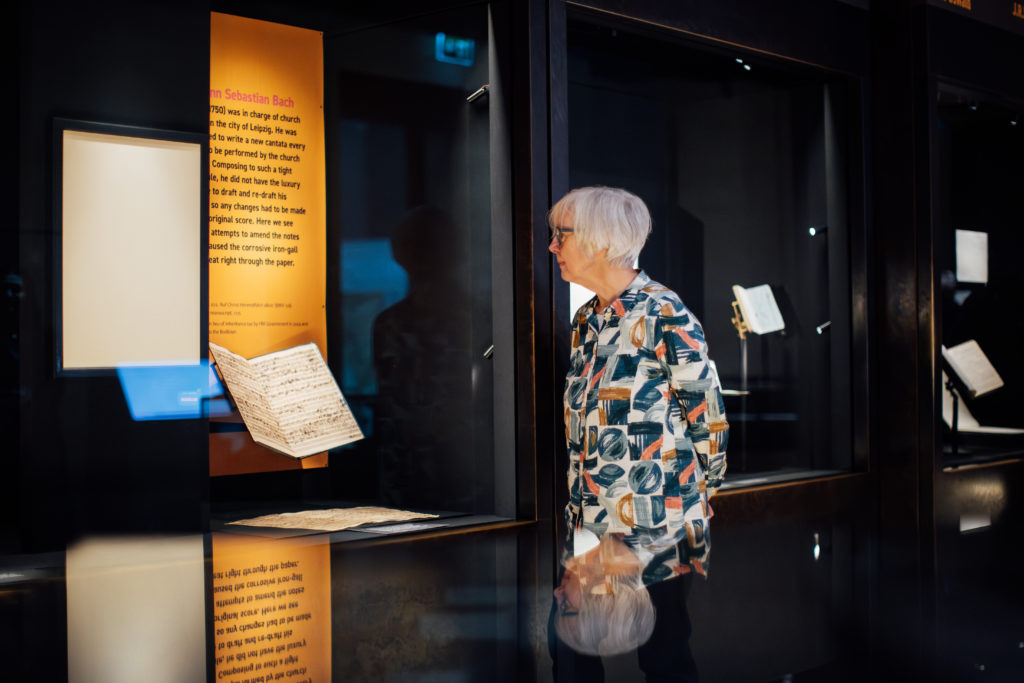
Auf Christi Himmelfahrt allein
Auf Christi Himmelfahrt allein was composed for the feast of the Ascension, 10 May 1725, celebrating Christ’s triumphant rise to Heaven forty days after the Resurrection, but it did not appear in print until 1878, 150 years after it was composed.
The short, festive cantata, which lasts less than 20 minutes in performance, is scored for two horns, three different types of oboe, trumpet, strings and continuo, with four-part chorus, and alto, tenor and bass soloists. Its five movements comprise a celebratory opening chorus, a short recitative and aria for bass voice, a duet for alto and tenor, ending with a simple chorale. The music for this cantata was all new, which is relatively unusual for Bach who frequently recycled and adapted movements from his other compositions.
The text for Auf Christi Himmelfahrt allein was written by Marianne von Ziegler—the only known female librettist Bach worked with. A pioneering figure in 18th-century Leipzig, von Ziegler was an accomplished poet and intellectual who defied societal norms, gaining recognition in her lifetime without adopting a male pseudonym. Her collaborations with Bach in 1725 produced a sequence of extraordinary cantatas, yet the full extent of their working relationship remains a mystery.
Bach 1725 is taking place on Wednesday 7 May at the Sheldonian Theatre – tickets are available now. You can also look at the Kohn manuscript online on Digital Bodleian.
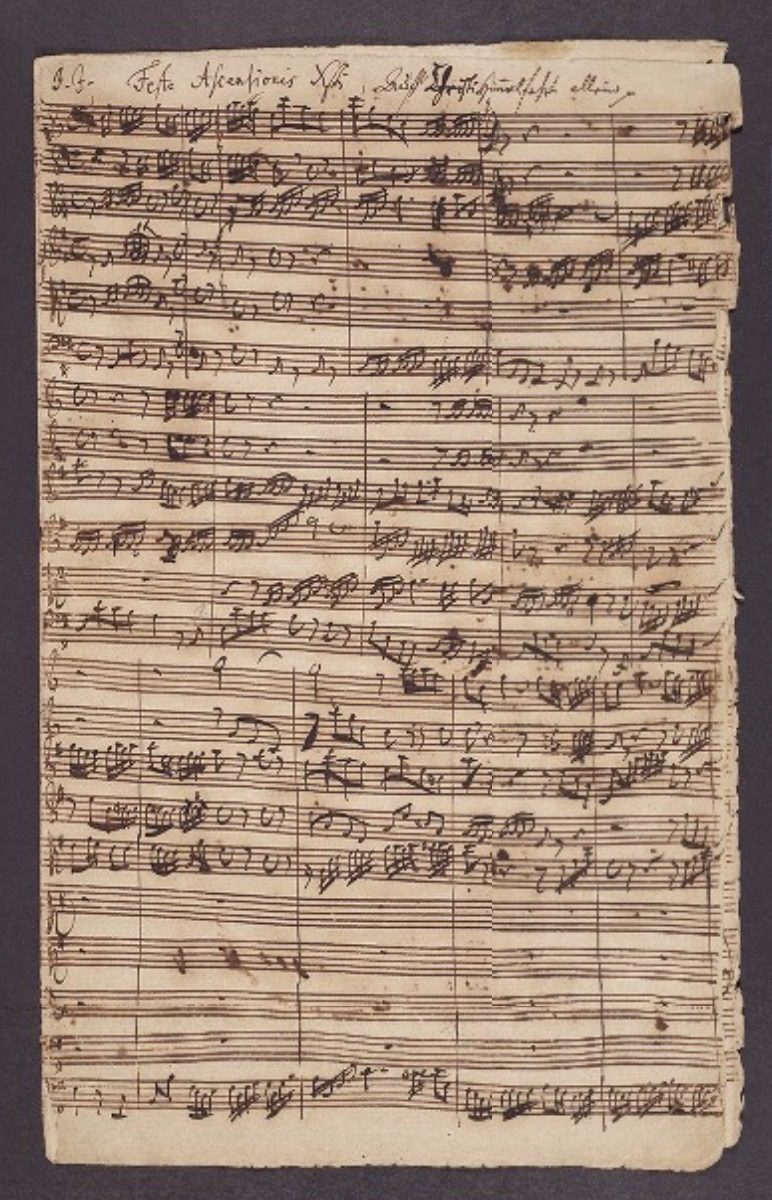
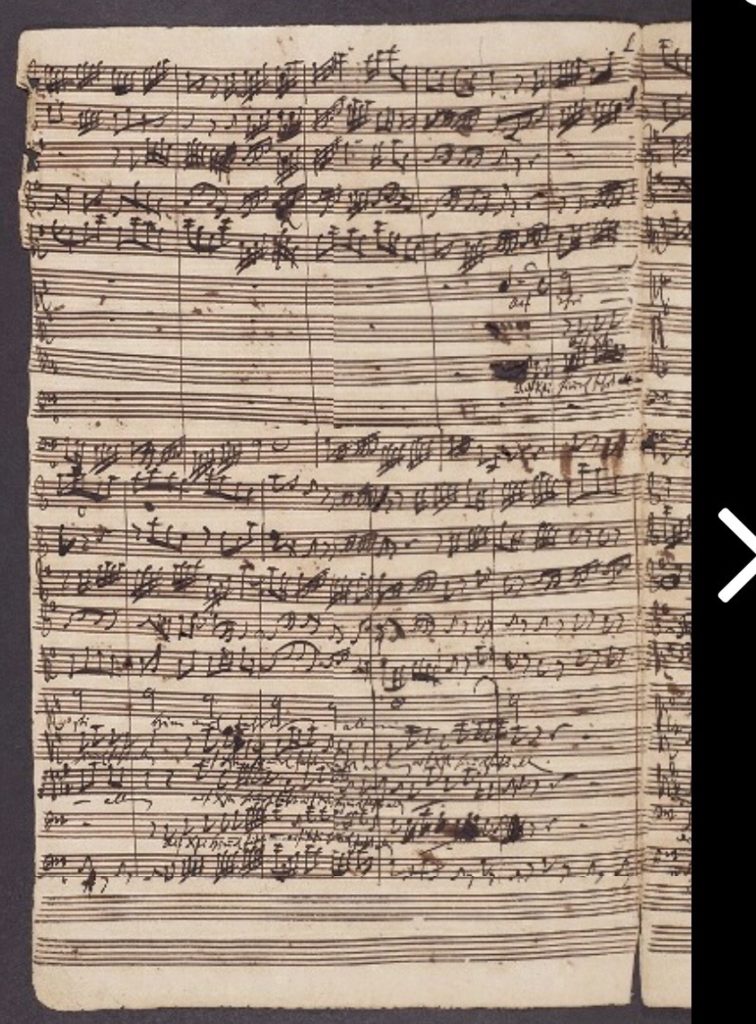

In 1725, Johann Sebastian Bach partnered with poet Christiana Mariana von Ziegler for a series of nine cantatas. Bach’s compositions combine choral and instrumental music, and were crafted to enhance the religious services of the Lutheran church throughout the liturgical year.
Christiana Mariana von Ziegler assisted Bach as his librettist – she provided the words to be used alongside his music. This International Women’s Day, we’re uncovering a lesser-known chapter in the history of Johann Sebastian Bach’s cantata for Ascension Day: ‘Auf Christi Himmelfahrt allein’ (BWV 128), Kohn manuscript, which was acquired by the Bodleian Library in 2024.
Ahead of the Bach 1725 celebration this spring, marking 300 years since the first performance of Bach’s cantata for Ascension Day, join Professor Henrike Lähnemann as she explores the life, legacy, and contributions of one of Bach’s key collaborators.
In 1725, Johann Sebastian Bach faced a dilemma: he had run out of texts for the weekly offering of cantatas to be performed in the main churches of Leipzig, and there were still nine Sundays to fill for the prime festive season of the year, from Jubilate Sunday (the third after Easter) via Ascension and Whitsun to Trinity Sunday, the feast that still gives its name to Oxford’s third term. To his rescue came a young woman, Christiana Mariana von Ziegler (1695–1760). She provided, with a remarkably quick turn-around, the libretti for the Sundays that Bach was still missing in order to complete his second choral cantata cycle, among them the Ascension Day cantata ‘Auf Christi Himmelfahrt allein’ which became BWV 128, the autograph manuscript of which is now held in the Bodleian Library. Who was this woman who could so readily produce singable verse which would be very publicly performed in the city space?
Christiana Mariana von Ziegler held an unusual position in Leipzig at the time. Having already been widowed twice and having lost the children from both marriages, she returned to her mother’s house in Leipzig in 1722 and turned it into a literary and musical salon – one of the few artistic meeting places Leipzig had to offer, and Bach, who took the position as Thomaskantor (musical director) in 1723, was a regular visitor, as well as Johann Christoph Gottsched (1700–1766), the heavy-weight critic of his age who arrived in Leipzig in 1724.
The cantata collaboration of Ziegler and Bach is a product of this artistic networking in the Leipzig circle. Particularly fascinating is that the cantata text shows an ongoing debate about the nature of religious poetry. Ziegler’s secular texts tended to display enlightenment characteristics: critical, satirical, formally balanced and full of learned references. Bach, on the other side, usually chose libretto writers close to the Pietist movement of his time and kept his distance to the rationalist style of poetry of the Gottsched circle.
Ziegler’s cantata texts show that she tried to accommodate Bach’s wishes and completely dispensed with the unusual comparisons and playful allegories that she otherwise loved. For the cantatas, she, like Bach’s other lyricists, drew from the sermon literature of the time and incorporated traditional exegetical material. The argumentation structure of the cantata BWV 128 depends on the popular sermon cycle Evangelischer Hertzens-Spiegel (‘Gospel-based Mirror for the Heart’, 1679) by the theologian and poet Heinrich Müller (1631–1675), which was continuously reprinted until in the 18th and 19th centuries and formed part of both von Ziegler’s and Bach’s library. Still, Bach intervened more heavily with her libretti than with any other text he set, emphasizing biblical quotations and adding a warning against trying to intellectually grasp God’s secret. Reading his autograph manuscript against her published version of the cantata text opens up a glimpse into the intellectual debates about religion and human understanding which must have been going on in the meetings at Ziegler’s house.
What became of Ziegler after this collaboration with Bach? She published the cantata texts four years later, joined with other devotional poems to form a cycle ( ‘Andächtige Gedichte’) in the second volume of her ‘Versuch in gebundener Schreib-Art’ (‘attempt in the art of verse writing’), which earned her as first and only woman a membership of Gottsched’s ‘Deutsche Gesellschaft’. This ‘German Literary Society’ was part of the early enlightenment movement and publicly active to promote German literature and language. This in turn made Ziegler eligible for the society’s annual poetry prize which she won twice, in 1732 and 1734. On 17 October 1733, she was made Poet Laureate by the University of Wittenberg – the Baroque equivalent of the Noble Prize for Literature. Her early collaboration with Bach was clearly an indication of great things to come!
When I grew up in the 70s and 80s, the two pink paperback volumes of Alfred Dürr’s edition of Bach cantata texts had their permanent place next to the radio on the bookshelf in the vicarage of my grandparents, to be perused on Sunday mornings to follow the text of the weekly broadcast of the Bach cantata for the day. It was a cultural practice in many households around Germany and the common sentiment was: ‘wonderful music, pity about the text’ – the emotional piety focussing on the wounds of Christ and Baroque exuberance of images sat uneasily with post-war sober and minimalist aesthetics.
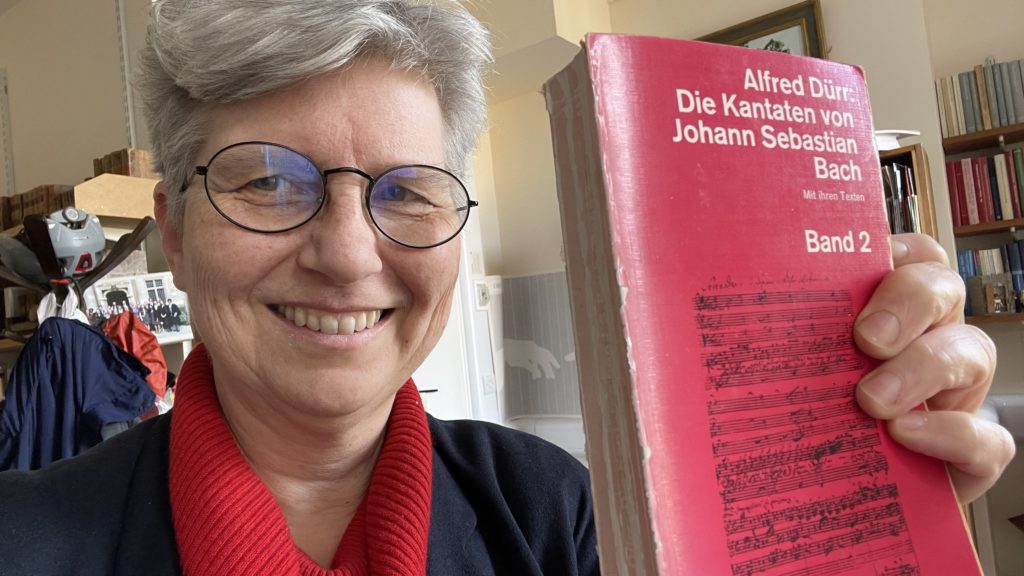
When Elke Axmacher, a young lecturer at the Kirchliche Hochschule Berlin, a theological college then part of the Freie Universität, offered a seminar in the summer term of 1991 focussing on the theology, imagery and rhetoric of the cantata texts, I was intrigued. I borrowed my grandparents’ by now faded pink volumes and set out to read my way through it from the perspective as literature. I was most struck by the aesthetic sense and well-crafted poetics of the Ascension Cantata by Christiane Mariane von Ziegler. And I was also fascinated when I realised that it was the cantata text with which Bach had probably most heavily intervened and wrote my essay for the course on this cantata. Imagine my delight when 33 years after this seminar I learned that the Bodleian Library had acquired the autograph manuscript of this particular cantata – and that this coincides with the start of a major new edition project at the University of Karlsruhe which will highlight the feminist and enlightenment aspects of Ziegler’s work.
I am looking forward to a workshop with musicologists, theologians, and philologists in May from Germany, Switzerland and Britain to discuss Ziegler’s texts after listening to Bach’s setting of her cantata text in the glorious surroundings of the Sheldonian Theatre!
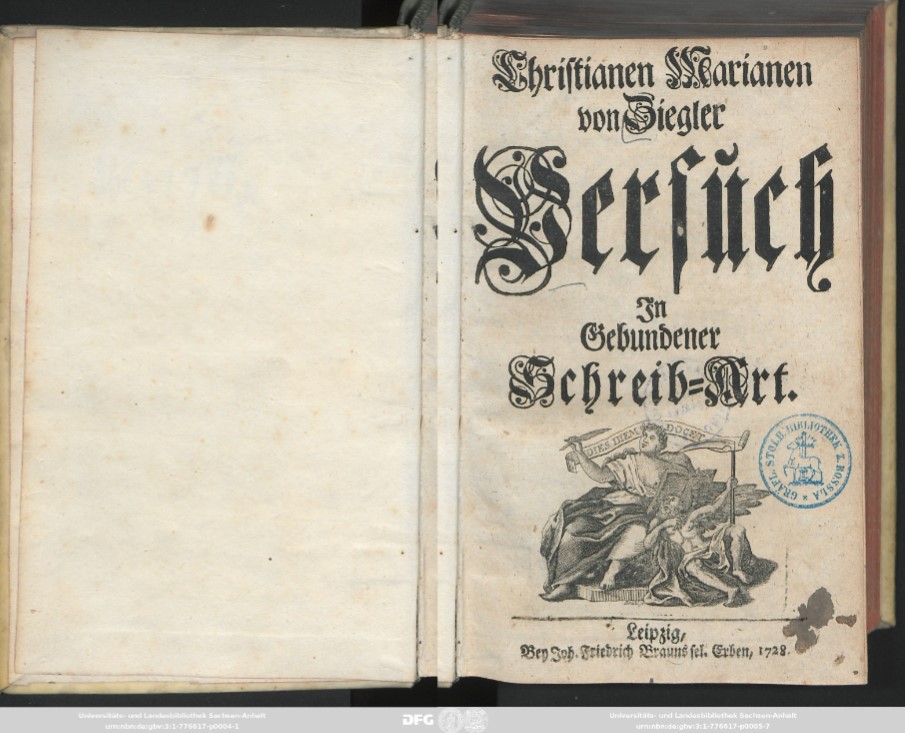
Tickets for the Bach 1725 celebration on Wednesday 7 May, including a manuscript viewing and evening performance by the Orchestra of the Age of Enlightenment and the Choir of New College Oxford, are available now.
On Friday 28th February we followed Kaleidoscope Chamber Collective for a day dedicated to exploring the powerful connections between music and wellbeing. Join us as we reflect on this thought-provoking and transformative event.
We started the morning with a rejuvenating early morning yoga session in Blackwell Hall, led by Kaleidoscope performer and yoga teacher Elena Urioste. Aimed at musicians and performers, but open to all, the class set the stage for an uplifting and inspiring day ahead.
Our mid-morning coffee was accompanied by beautiful music in Blackwell Hall, with a pop up preview performance from two members of the Collective.
This was followed by a thought-provoking ‘Thriving in the Spotlight’ panel discussion in the Sheldonian Theatre. Professor Eric Clarke, Emeritus Professor of Music, spoke with Kaleidoscope Chamber Collective about the physical and mental pressures faced by musicians, often hidden behind the music. The panel shared their own experiences with the audience, and ways they work to overcome challenging feelings before, during, and after performing.
The day concluded with an immersive evening concert in which guests were encouraged to enjoy a truly individual listening experience, with moments of personal reflection, and a celebration of the audience’s shared connection. At the start of the performance, Elena Urioste led the audience in a breathing exercise. Some guests opted to relax on beanbags in the round, inspiring a fresh take on the traditional concert experience. Guests were taken on a journey of musical discovery, with a repertoire exploring themes of dreams, hope, and spirituality.
The evening began with a stunning atmospheric solo performance by Jonathan Leibovitz, who played a Chinese folk song, Xiǎo hé tǎng shuǐ (Flowing River), from the top of the Sheldonian. Many audience members, still immersed in the calm of the earlier breathing exercises, kept their eyes closed, enhancing the meditative atmosphere.
This tranquil moment was followed by an energetic duo performance on violins from Elena Urioste and Savitri Grier, who performed Jessie Montgomery’s vibrant composition, Musings for two violins. Rosalind Ventris (viola) joined the stage for a beautiful rendition of Persian folk songs, Agar yār-ī-manī and Bodo bodo bodo, newly arranged by Kaleidoscope founder Tom Poster.
The mood shifted to a more reflective tone as Laura van der Heijden (cello) joined for Beethoven’s emotional String Quartet in A minor, Op. 132. Composed as a gesture of gratitude following a period of serious illness, the piece conveyed deep emotions of relief, and appreciation for health and for life.
The concert concluded with a captivating quintet performance of The Dreams and Prayers of Isaac the Blind, a work that traces the history of Judaism and explores themes of language, memory, and identity. The piece, a moving exploration of cultural and spiritual history, brought the evening to a powerful close.
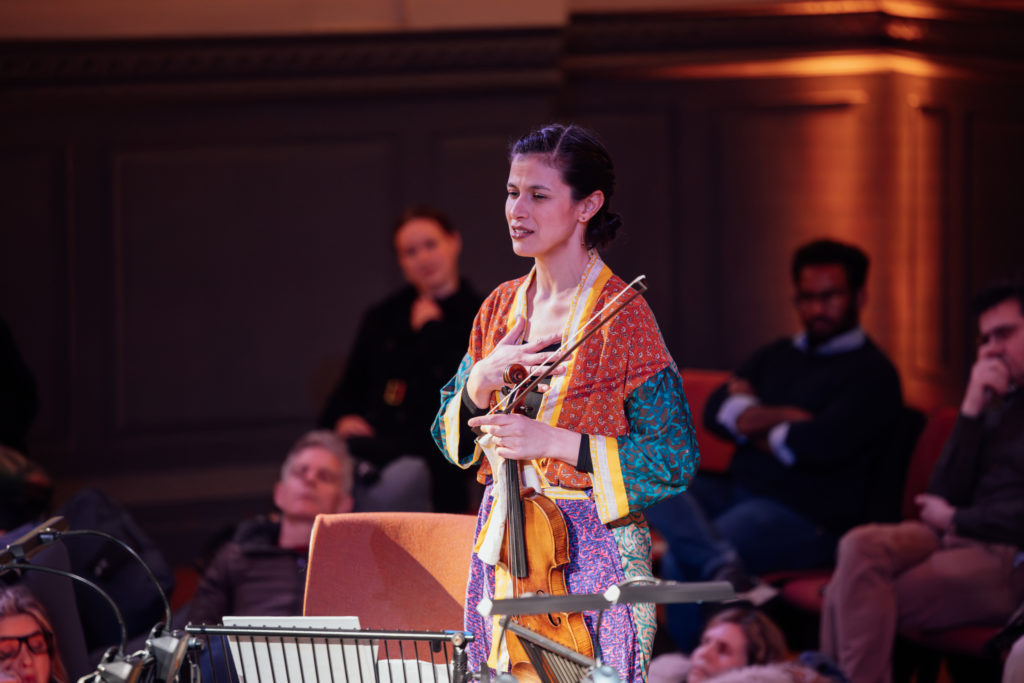
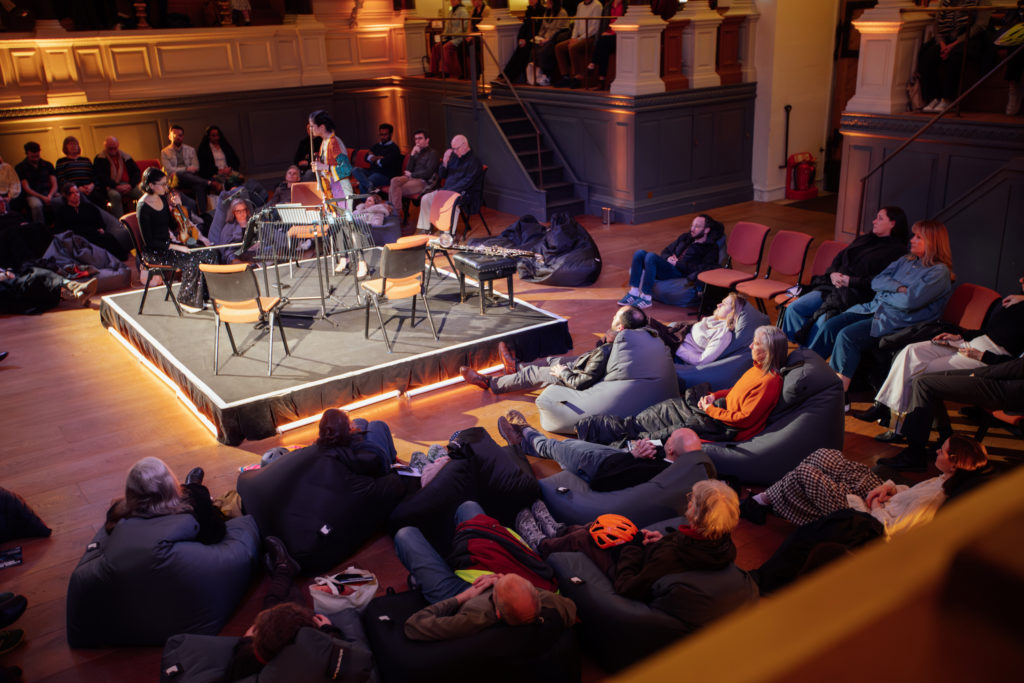
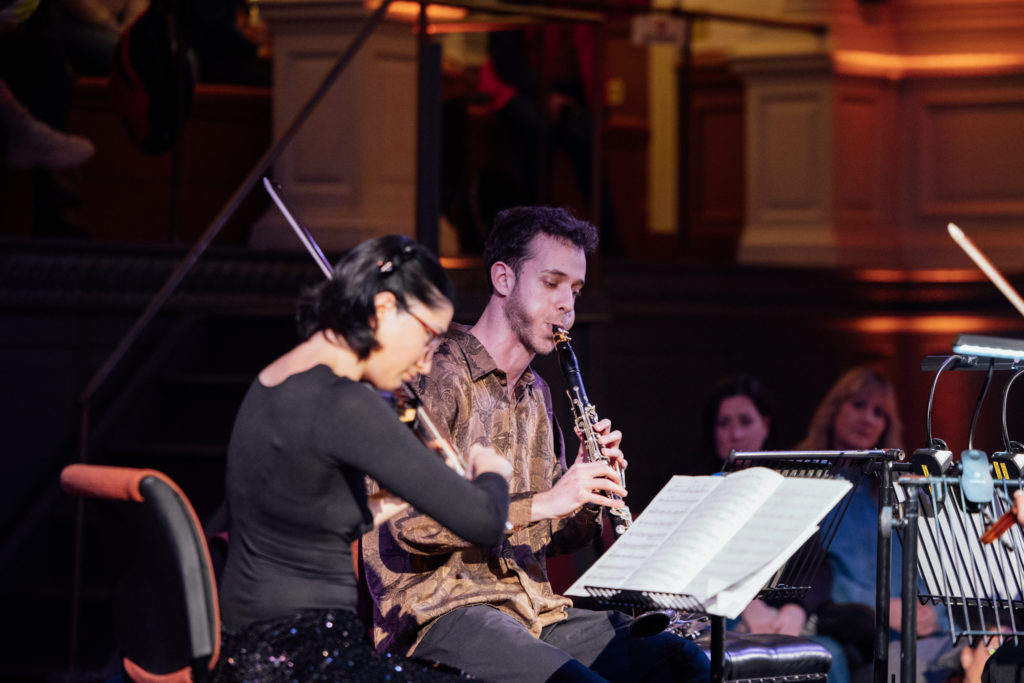
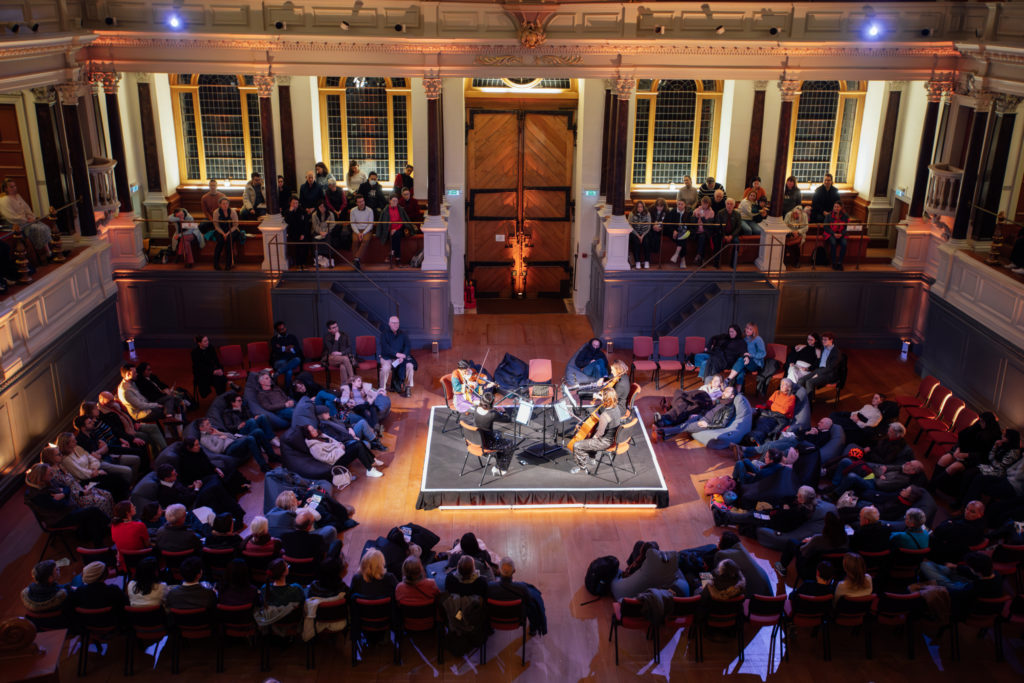
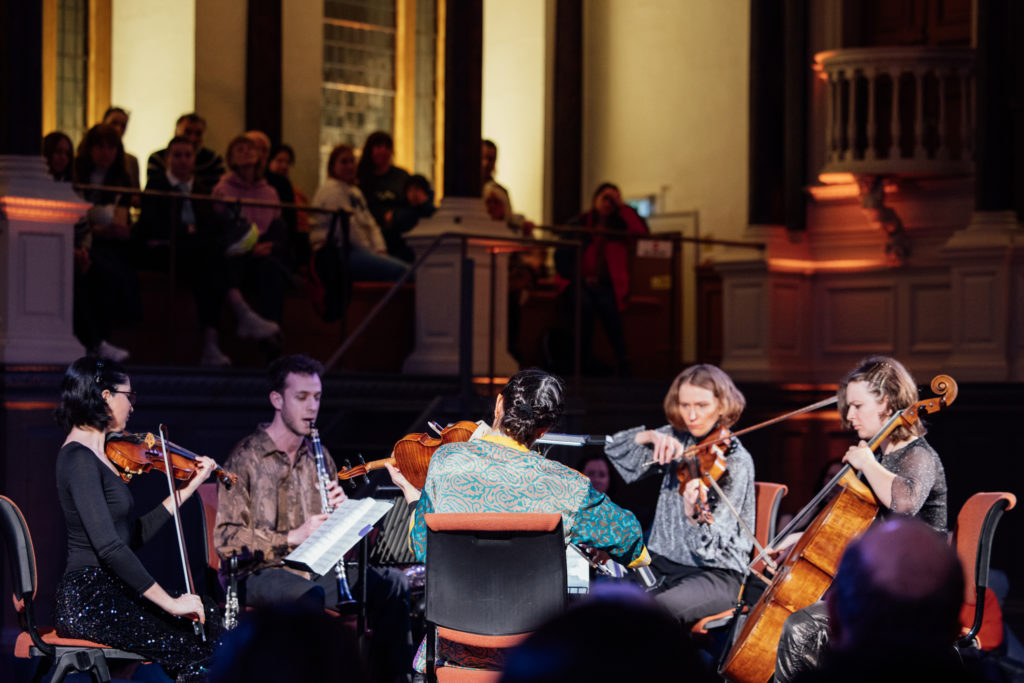

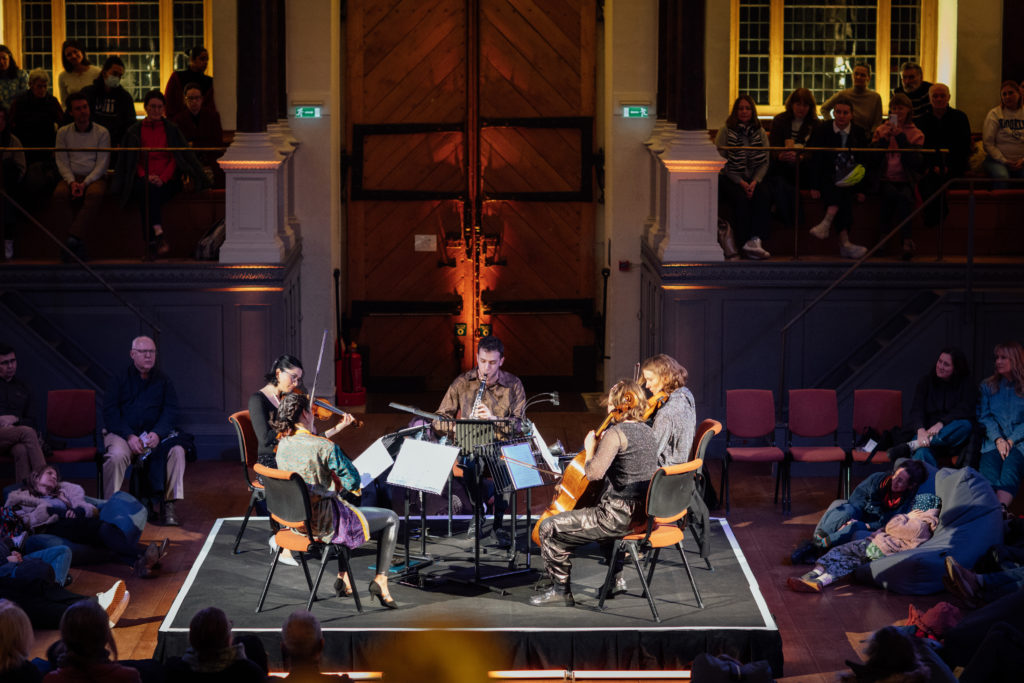
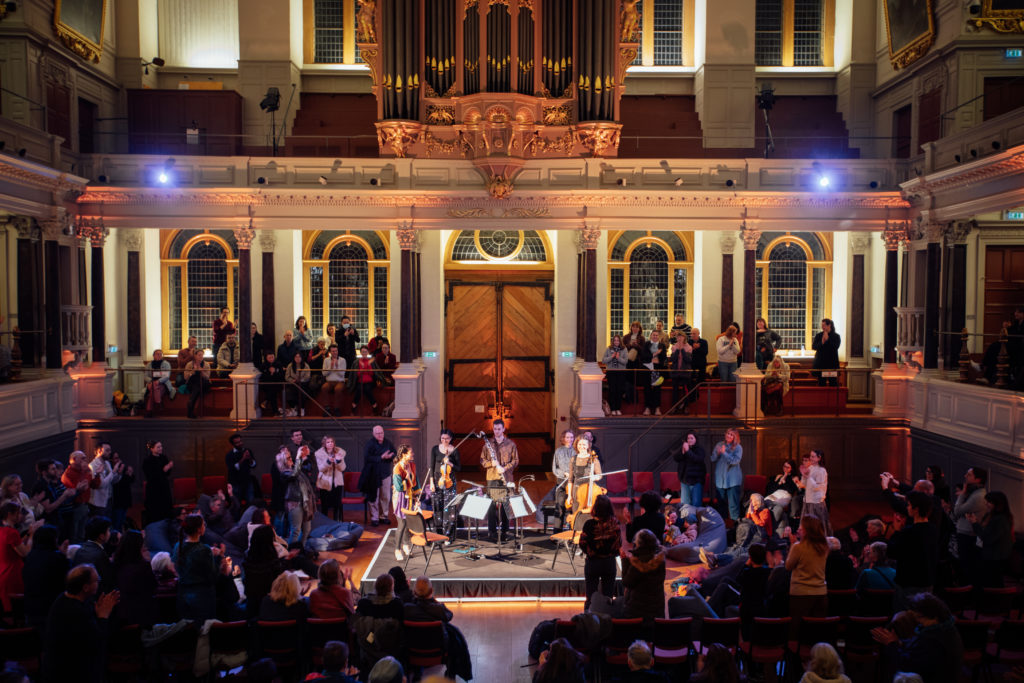
On Saturday 5 July 2025 we will come together again for food, stalls, music, dance, sports, arts, crafts, fashion, theatre, and spoken word as part of the Leys Festival. It will be a celebration of our community, and an important event in Oxford’s calendar. The Leys Festival was planned and made last summer (2024) by a group of residents of Blackbird Leys and Greater Leys working with a team from the Cultural Programme at the University of Oxford. Watch highlights from last year’s festival:
This year the Festival will return to Blackbird Leys Park on Saturday 5 July. The planning group (Residents and University) have already started dreaming up an even bigger and better event and are looking for anyone who would like to get involved.
The theme will be One People One Place, and we will celebrate all the bridges we build in our community. There will be food, stalls, music, dance, sport, arts, crafts, fashion, exhibitions, spoken word and theatre, all from The Leys.
WE NEED YOUR HELP
We want to make sure that as many voices as possible are included in the Festival and we’d love to hear your ideas, we also need plenty of volunteers to make the Festival happen. We promise you’ll have fun!
There are three ways to get involved:
1. Help plan the festival
There are four steering meetings to go—always at 6-8 p.m., always with excellent food from OCA! Please come because it is where we really make sure everyone knows what is going on and can make their voice heard.
- Thursday 29th May, at Oxford Hub
- Thursday 12th June, at Activate Learning
- Thursday 26th June, at Activate Learning
- Thursday 3rd July, at Activate Learning
Join a working group – small groups of volunteers who meet online looking at the following areas:
- The Food Festival and Stalls
- Schools and youth groups
- Music/Dance/Stage programme
- Fundraising
- Mentoring and skills
- Stories of the Leys
2. Get Creative
Let us know you would like to perform, or host a stall or an activity at the Festival. Everyone welcome so let us know what you’d like to do and we will try to fit you in.
OR
Share a story about The Leys, about the history or the future of this place or about a person who has made a difference or just something funny or interesting about this community.
OR
Join a singing workshop to create a song for The Leys.
For DJs, dancers, and music performers: please complete the Stage + Performance Form. The deadline is the 6th June.
take part
Interested in getting involved? Whether you’re a food vendor, a community stallholder, or a young baker ready to show off your skills, we’d love to hear from you! Sign up below to take part — the deadlines for food and general stalls are 29 May, and the Young People’s Bake Off deadline is 9 June.
- Food Stalls Sign-Up Form – deadline is the 29th of May
- General Stalls Sign-up Form – deadline is the 29th of May
- Young People Bake Off Sign-up form deadline 9th June
- Weekly bunting-making sessions happen every Monday, 10am-12pm, at Oxford Hub
3. Volunteer on the day
We’ll need loads of people to help make the event welcoming, safe and fun. You could:
Volunteer to run a workshop in a school or community group to get people involved (this could be music, art, craft, exercise, collecting memories, building bridges).
OR
Volunteer to share your skills or experience – if you have ever delivered an event, produced a gig, raised money, done a risk assessment, and would like to help, let us know.
If you are interested, please email our festival producer at nassy.konan@humanities.ox.ac.uk by 9th June, with your name, contact details, and a brief description of what you would like to do.



Ahead of a special evening performance this March, in which Oxford schoolchildren will bring their visions of an ideal town to life through original music and theatre, Giles Masters (Fellow, Magdalen College) delves into the inspiration behind the project and highlights the essential role of play in learning and development. This behind-the-scenes look at the collaboration between researchers and primary school students explores the influence of music and theatre experiment, Wir Bauen Eine Stadt (1930), and its relevance for children today.
Red light! Green light! Motorway! Four eight-year-olds are telling me how you play a game called ‘Cars’. (Initially, there’s some debate about whether the name is actually ‘Beans’, but on reflection we decide this is unlikely.) Folded into a tiny red plastic chair – an adult guest in their primary school classroom – I learn that the game, which they play in PE, involves responding to verbal prompts from a leader or teacher. ‘Green light!’ means go; ‘red light!’ means stop. ‘Tow truck!’ means find a partner and hold their hand. ‘Mini car!’ means shuffle along with your knees bent in a kind of squat. (Children find this easier than grown-ups.) And if you hear ‘motorway!’, run as fast as you can. The game ends with ‘park!’: everyone sits down. For the children, recalling and demonstrating each of these actions quickly becomes its own kind of game: a game about the power of memory, about the satisfaction of communicating something important to an ignorant adult (who doesn’t know ‘Cars’?), and about the almost unbearable question of how long they’ll have to wait before they play the real thing again.
This isn’t what I usually get up to in my job. As a music historian, I’m most often to be found in an archive or library somewhere or teaching young adults and marking their essays. In the project that brought me into this primary school classroom, those familiar ways of thinking about knowledge and learning in a university humanities department remain essential. But the aim is to put them to more creative, experimental ends, involving a much bigger, more varied team of collaborators and a lot more running around pretending to be cars.

On behalf of Music at Oxford, with kind permission of Schott Music, Mainz, Germany.
The project, Let’s Build a Town!, began in summer 2023, when I took the initial germ of an idea to Felicity Newby-Smith, who runs the Learning and Participation programme for Music at Oxford, a local arts organisation. The starting point was my research into Wir bauen eine Stadt (Let’s Build a Town) by the German composer Paul Hindemith. In summer 1931, this short, recently composed experiment in music theatre was performed by British schoolchildren in Oxford’s Holywell Music Room. This fascinating, basically unknown historical event sparked us to think about how the piece might be revived and reimagined in Oxford today.
We found two aspects of Wir bauen eine Stadt especially inspiring. First, the work invites children to imagine a city where there are no adults and they are in charge. This classic scenario (explored most famously, and disturbingly, in English-language literature in William Golding’s 1954 novel Lord of the Flies) is presented optimistically here as a kind of urban utopia. During the piece, the children think about the different kinds of infrastructure that make up a city, such as transport. They imagine what kinds of roles they might take up in this new society. (We’ll still need a dentist.) And they teach us about the importance of working together to get things done. Today, in Oxford and across the country, debates around urban planning, citizenship, and belonging are urgent and often highly divisive. In this context, Wir bauen eine Stadt offers rich opportunities for young people to develop and express their views on local history, geography, and politics, and to foreground their voices, so easily ignored, in renewed and less polarised public discussions on these themes. How do children in twenty-first-century Oxford think about their city, we wondered, and if they were in charge, what kind of place and community would they want to live in? After all, they are the ones who will have to live with the decisions we make today.
Second, Wir bauen eine Stadt is suffused with the belief, widespread among progressive-minded artists and teachers of Hindemith’s generation, that games and play are essential to fostering children’s learning, social development, and enjoyment of the arts. That belief makes a refreshing contrast with the narrow views of education that have squeezed the space for creativity and performance in UK school curricula over the past decade or so. Hindemith’s main collaborator, a writer called Robert Seitz, came up with material for Wir bauen eine Stadt by observing playground games that early twentieth-century German children played of their own accord and translating these into corresponding dramatic situations (so we get, for example, a night-time caper involving cops and robbers). Felicity and I wanted to explore what might happen if we took this ethos one step further: that is, if instead of simply harvesting ideas from children’s games (and then retreating to the risk-averse territory of getting children to learn words and music written by adults), we made play a more integral part of the creative process and performance. With this aim in mind, we devised a project in which young people would be empowered to build and perform a new, more genuinely playful, version of Hindemith’s ‘town’, in which scenes from the original work would be interwoven with new co-created music and theatre exploring the same themes from the twenty-first-century perspectives of the children taking part.
In late 2023, the project was awarded incubation funding from the Cultural Programme. This support enabled us to organise two developmental workshop days in July and September 2024 at St Francis CofE Primary School in east Oxford. (St Francis, our main partner school, has an existing link with the Outreach and Access Team at Magdalen College, where I am a Fellow by Examination.)
We were lucky to have a brilliant team of artists and workshop leaders: Emma-Jane Greig (movement), Oliver Grant (theatre), Tabitha Grove (design), Tim Keasley (music lead), Rose Martin (music/singing coach), Anna Pool (director), Lauren Spiceley (music/instrumentalist), and Natalie Wong (movement). The team was completed by Dr Lucy Hunt, who led evaluation of the incubation period, with support from Erin Townsend (a third-year undergraduate music student).
During the workshop days, we split our time between developing ideas as a project team and working directly with young people in Years 4 and 5 (aged 8–10). We focused especially on collecting different kinds of games, drawing on the collective knowledge of the children and grown-ups, and thinking about how they might be used or adapted for the project. We also worked with some of the children to try out new games we had just invented and to draw a big collective map of their ideal town. In July we led a whole-school singing assembly, and in September we taught both classes we’re working with one of the songs by Hindemith. At the end of the assembly, the St Francis community gave us a very special surprise, singing ‘The Trees of the Fields Will Clap Their Hands’, one of their favourite songs, just for us.



Working with games and play raised a host of fascinating questions, philosophical and practical. What do these terms actually mean? Can we draw a clear boundary between them? And how might we categorise the myriad activities they refer to? One helpful parameter was structure: how much what an individual does is governed by rules. At one end of this scale, we might put organised sports and certain board games. At the other, there are freer activities that rely more on the imagination (such as ‘Playing House’). Many games fall between these extremes. Other parameters and categories that seemed important included the number of players, the presence or absence of a leader figure (like in ‘Cars’), and the amount of energy and physical exertion required (an important consideration when planning workshops with primary school children!). We also tracked the continuities and changes between the games the young people talked about enjoying, the ones we remembered from our own childhoods, and the ones that feature in Hindemith’s piece. We learnt, for instance, that these children still play ‘Grandmother’s Footsteps’ – but, disconcertingly, they call it ‘Squid Game’. In the playground, word-of-mouth knowledge and popular culture are constantly colliding in new ways.
What has been most rewarding, after many months of planning, has been to start collaborating with the children in meaningful and even inspiring ways. As the Year 4 class teacher wrote to us after the September workshop, ‘The children’s engagement has been incredibly high due to the wealth of skills and enthusiasm of the adults involved as well as the carefully thought-out activities. The sessions have been accessible for all children, and it has been great to see positive engagement from those who may not usually see performing or music as “their thing”. Children were left with an excited buzz about the project.’ A town worth living in can’t be built in a day. But during this first phase of the project, we’ve worked hard to lay down the best foundations we can. We look forward to sharing more updates with you, and we hope you can join us for the final performance in March!
‘Let’s Build a Town’ is produced by Music at Oxford in collaboration with The University of Oxford’s Cultural Programme, and with the support of the Faculty of Music, Magdalen College, RETUNE Festival and the Marchus Trust.
Join Giles Masters and members of the artistic team on 5th March for a unique opportunity to explore the research and creative work behind the project at a pre-concert discussion and workshop. Tickets are free and available now from Florence Park Talks.
Enjoy original music and theatre created as part of the project on 14th March – a new town will be imagined and built before your eyes and ears! Find out more about the ‘Let’s Build a Town‘ evening concert. – tickets are available now.
